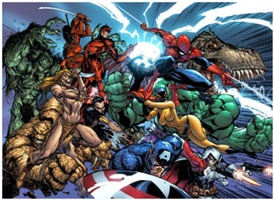Most people think of superheroes when they think of Comics & Graphic Novels. But in fact, there are several other genres for fans to enjoy such as horror, humor, romance, childrens’, science fiction, fantasy, action/adventure, alternative/esoteric, manga, and adult comics.

This graphic cult has many followers. Some are in love with the characters; some with the artwork. Some people enjoy listening to a story told through pictures. While the simplicity of comics is universal, the artwork herein can vary according to the countries they were created in. While the comic industries in Japan, Europe and the US are well established, it is still nascent in markets like the Middle East & India.
The style of Artworks in Graphic novels and comics can be broadly divided into the following groups.
American Style

Regarded the forefathers of the industry, the American style is hugely popular and accepted worldwide as a form of comic art that many would-be artists try to learn from. This style is known as the Adventure style. It is based on realistic anatomy taken to an extreme stage. Anatomies are emphasized and the backgrounds are also well defined. Popular examples include Marvel and DC comics.
Some of the American comic’s artists whose art I admire and try to learn from:
- Jim Lee – a Korean-American comic book artist, writer, editor and publisher
- Frank Miller – an American writer, artist & director best known for his dark, film noir-style comic book stories and graphic novels like Ronin, Batman: The Dark Knight Returns, Sin City and 300.
- Alex Ross -an American comic book writer/artist known primarily for his realistic painted characters, interiors, covers and design work.
- Frank Cho – Known for his figure drawing, precision lines, & depiction of well-endowed women.

Cartoon Style
The cartoon style of art creates a simplified version of everyday reality. The subjects drawn in this style rely on only a few of the physical features. Think of Bone or Bugs Bunny. They often take advantage of an exaggerated part of the animal or human form while leaving out many details. This style also includes anthropomorphic characters.

For instance, The Beano –a UK based cartoon character, is loved for its silly humor and jokes. It is clearly aimed at children as it’s all about mischief and naughtiness.
On the other hand Viz is the raunchier, more ‘mature’ comic for adults. Inspired by Beano, Viz has the same level of daftness, but for grown-ups.

Manga Style
Anime and manga–which come from Japan–are similar in many ways. They feature large eyes, big hair and dramatic speech bubbles. They can either be hand-drawn or computer generated. The style is dramatically different from an American superhero look. The characters in anime and manga show emotions in an exaggerated way, run with speed lines and frequently have very long limbs.

Manga comics, increasingly popular with all age groups in Japan, deal with themes like school romance and literary classics, innocent tales and even adult content.
Apart from these, the other two major contributors to the comic industry are France and Belgium. Over the years, they have developed a particular style of art that is largely a blend of cartoon and semi realistic style of designing.There are various graphic design courses that help you create illustrating children books to design layout for tabloids, book covers, motion graphics, UI design, creative posters, traditional animation and corporate brand designs. It prepares you to join the ever-expanding world of print and visual media by providing you a detailed insight on graphic, web design and 2D animation.

Tintin (Belgian) and Asterix (French) are the best known examples of this style.
Indian comics like Chacha Chaudhry, Amar Chitra Katha & Indrajaal comics have been an integral part of our childhood. Alternately, Indian graphic novels sometimes also have darker plots& more mature content. The stories are deeper, using experimental art forms and they are being marketed towards a niche audience.
For instance, check out the following artwork by Sarnath Banerjee and Amruta Patil for their respective graphic novels.

As a culturally rich and diverse nation, we still have a long way to go in the graphics design sector. As someone rightly said, “Every renaissance comes to the world with a cry, the cry of the human spirit to be free”. We are indeed ready to be set free!
